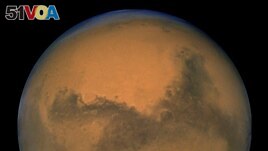07 May 2023
A new study suggests water may have existed on Mars much more recently than past evidence has shown.
The research is based on data collected by China's Zhurong explorer vehicle. The explorer, or rover, arrived on the planet in 2021.
Evidence of surface water was found in warmer areas of Mars that might have been fertile enough to support conditions for life, the researchers said. A study reporting the results was recently published in Science Advances.

This Aug. 26, 2003, image made available by NASA, shows Mars as it lines up with the Sun and the Earth. (NASA/J. Bell - Cornell U./M. Wolff - SSI via AP, File)
A scientific team from China's Institute of Geology and Geophysics led the research. The institute is part of the Chinese Academy of Sciences.
Today, Mars has a cold, desert climate. But past studies have provided evidence that ancient Mars had large amounts of water. This is believed to have included rivers, lakes and oceans. A 2015 study by the American space agency NASA suggested that 4.3 billion years ago, Mars likely had an ocean covering nearly half of the planet's northern hemisphere.
There are different theories for what caused large amounts of water to disappear from Mars. The most likely explanation is that the liquid escaped when the planet's atmosphere thinned over time, NASA explains. This let the water evaporate, turning the Martian surface into a frozen desert. The space agency estimates the evaporation happened about 3 billion years ago.
In the new study, researchers said the Chinese rover observed salt-rich sand dunes on the surface. The dunes contained breaks, crusts and small hills. The team said these landforms provide evidence that land had frozen and then melted in the areas studied. The melting could have happened as recently as a few hundred thousand years ago, the study said.
The rover's observations were made in an area called Utopia Planitia, a large flat area, called a plain, in Mars's northern hemisphere. The researchers said they believe the dunes were likely formed sometime after 1.4 million to 400,000 years ago, possibly even more recently. Conditions during that period were likely similar to how things are on Mars today.
Xiaoguang Qin is with the Institute of Geology and Geophysics and was a co-writer of the study. He told The Associated Press (AP), "We think it could be a small amount...no more than a film of water on the surface."
The rover did not directly observe water in the form of frost or ice. But Qin said computer modeling and observations by other spacecraft on Mars suggest that even today, at some times of the year, conditions could be right for water to appear.
Planetary scientist Frederic Schmidt is with the University of Paris-Saclay. He was not part of the study. But he said he finds the results notable because they demonstrate how young the dunes are. "This is clearly a new piece of science" for the area, Schmidt told the AP.
The researchers said they believe small openings filled with salty water were created by melting frost or snow. This likely resulted in the small cracks, hard crusty material and other surface changes observed by the rover. The team ruled out wind as a cause, as well as frost made of carbon dioxide, which makes up most of the Martian atmosphere.
The rover has now provided "evidence that there may be a wider distribution of this process on Mars than previously identified," said Mary Bourke. She is an expert in Mars geology at Trinity College Dublin in Ireland. She added that although the evidence suggests small amounts of water, it could still be important in identifying environments that could support life.
The findings were reported days after China confirmed its Zhurong rover has yet to wake up since going into hibernation for the Martian winter nearly a year ago. Chinese space officials have said the rover's solar equipment is likely covered with dust, blocking the sun and cutting power to the explorer.
Before it went silent, Zhurong had explored the Martian surface for 358 days and traveled 1,921 meters, space officials said. This was far longer than the rover's planned three-month operation, officials added.
I'm Bryan Lynn.
Bryan Lynn wrote this story for VOA Learning English, based on reports from The Associated Press, Reuters, the Chinese Academy of Sciences and Science Advances.
_________________________________________________________
Words in This Story
evaporate – v. when liquid changes from a solid state into a gas or vapor
dune – n. a hill of sand
crust – n. a hard, dry layer on the surface of something
frost – n. a thin, white layer of ice that forms on surfaces, especially at night when it is cold
distribute – v. to give something out to people or places
hibernate – v. to go into a sleeping state for a period of time